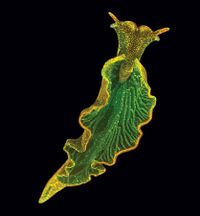Elysia chlorotica
Introduction

Elysia chlorotica (or the eastern emerald elysia) is a marine Gastropoda species in Plankobranchidae family, and clade in Sacoglossa. Elysia chlorotica (E. chlorotica) have been found in salt, tidal marshes, shallow creeks and ponds off the coast of the eastern states and in Nova Scotia, Canada, at depths of 0m to 0.5m. [1] The clade that E. chlorotica belongs to are sea slugs that are able to perform photosynthesis, known as "solar-powered sea slugs", which is unique among other sea slugs[2]. Species in this clade have been found an unusual phenomenon called "kleptoplasty", which means they can use living chloroplast where they get from algae for their own using. After they have been first feeding on algae, the chloroplast they obtain from algae will be preserved in their special digestive system and use for photosynthesis. The chloroplast remains in E. chlorotica will turn them into bright green.
Life cycle and Morphology

E. chlorotica is bilaterally symmetrical like a real leaf. Their morphology and green color ables them blending into the marsh environment easily. E. chlorotica's color is largely depend on the concentration of chlorophyII preserves in the digestive gland; Therefore, they will occasionally appear reddish and greyish in color[3]. The adult individual are around 3~5 centimeters long, some individuals can grow up to 6cm in length but are more commonly found between 2~3cm. An E. chlorotica has four stages of development: larval, juvenile, young adult and mature adult stages, which can be distinguish by its morphology and coloring.
Larval Stage
E. chlorotica's life start with veliger larva. They have a shell and ciliated vellum used for swimming and obtain food.[4] On the early stage, E. chlorotica larva feeds on small phytoplankton in the ocean water. Larva has two eyespots on two side of its mouth. The Ciliated vellumon at the outside of the mouth can constantly bring food into the digestive extract to the stomach. Then, food will be sorted and filtered in this process before it move on to the digestive gland. In digestive gland, nutrients in the food will be absorb by E. chlorotica (Figure 2.A).[5]
Juvenile Stage
During juvenile stage, newly hatched E. chlorotica are usually translucent brown, with few red spots on their bodies. This stage remains until the initial feeding on algae, Vaucheria litorea (Figure 2.B).
Young/Mature Adult Stage
Elysid refers to the adult slug’s leaf-like shape which is caused by two large lateral parapodia (a pair of fleshy protrusions like wings for swimming) on either side of its body. This morphology is beneficial as both camouflage and allowing the slug to be more efficient at photosynthesis. Other members of this family are distinguished by their parapodia in addition to bright coloring.The E. chlorotica obtains chloroplast from the algae, preserving in its special digestive tract. The presence of chloroplast gradually turns the body color into bright green, and lost red spots. It takes 3~5 days for E. chlorotica reach the threshold and transform to mature adult stage(Figure 2.D), before that some scientists will identify that period as a short young adult or intermediate stage(Figure 2.C)[6].
Sexual Reproduction
E. chlorotica is simultaneous hermaphrodite, which contains both female and male organ. It is theoretically possible that they can do self fertilization. However, most of E. chlorotica will mating with another individual. The egg will be fertilize inside the animal, and the animal will lay fertilized eggs in long chainsCite error: Closing </ref> missing for <ref> tag. RbcL gene, which encode Rubisco LS, has been found in E. chlorotica DNA; Rubisco LS protein is also presence after two month’s starvation. PsbA Genes were remain constant until 4 months of starvation and start to decline. The 16S rRNA gene stays at a constant level from start to finish. RbcS is also remains at a steady level. These genes are directly engage in chloroplast encoding which indicates E. chlorotica can constantly encoding new symbiotic chloroplast using gene information even without food (chloroplast) source. Furthermore, the transcription and translation of chloroplast occurred in the situation where plant nucleocytoplasm is absent; which means the regulation of chloroplast gene expression is taken by sea slug’s nucleus and cytosol; or completely regulate within the symbiotic plastid genome.
However, chloroplast in E. Cholotica is not inheritable, the acquisition, usage and maintenance of kleptoplasty will appears on sea slug after they been feed on Vaucheria litorea.
Feeding
Elysia chlorotica feeds on filamentous algae, the most well known type is Vaucheria litorea. When a E. chlorotica is eating, it will punctures the cell wall with its piercing teeth.Then, it holds the algal strand and sucks up the chloroplast and other cells insides the algae. E. chlorotica will store the chloroplast in their digestive system and using them for photosynthesis.
References
- ↑ Rumpho, Mary E., Elizabeth J. Summer, Brian J. Green, Theodore C. Fox, and James R. Manhart. 2001. “Mollusc/Algal Chloroplast Symbiosis: How Can Isolated Chloroplasts Continue to Function for Months in the Cytosol of a Sea Slug in the Absence of an Algal Nucleus?” Zoology 104 (3-4): 303–12. https://doi.org/10.1078/0944-2006-00036.
- ↑ Vries, Jan de, Gregor Christa, and Sven B. Gould. 2014. “Plastid Survival in the Cytosol of Animal Cells.” Trends in Plant Science 19 (6): 347–50. https://doi.org/10.1016/j.tplants.2014.03.010.
- ↑ Garge, Suvarna. 2017. “Elysia Chlorotica (Eastern Emerald Elysia) ~ Details with Photos | Videos.” Alchetron.com. August 18, 2017. https://alchetron.com/Elysia-chlorotica#elysia-chlorotica-68323d25-2b6b-482b-b585-501377b82a5-resize-750.jpeg.
- ↑ Blanchet, Chelsea. 2011. “Elysia Chlorotica.” Animal Diversity Web. 2011. https://animaldiversity.org/accounts/Elysia_chlorotica/.
- ↑ “SymBio: The Slug Elysia-Development.” 2011. Web.archive.org. April 17, 2011. https://web.archive.org/web/20110417045514/http://sbe.umaine.edu/symbio/3Slug/3development.html.
- ↑ Rumpho, M. E., J. M. Worful, J. Lee, K. Kannan, M. S. Tyler, D. Bhattacharya, A. Moustafa, and J. R. Manhart. 2008. “Horizontal Gene Transfer of the Algal Nuclear Gene PsbO to the Photosynthetic Sea Slug Elysia Chlorotica.” Proceedings of the National Academy of Sciences 105 (46): 17867–71. https://doi.org/10.1073/pnas.0804968105.
